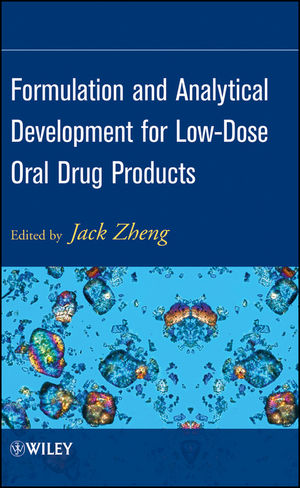Formulation and Analytical Development for Low-Dose Oral Drug ProductsISBN: 978-0-470-05609-7
Hardcover
496 pages
February 2009
 This is a Print-on-Demand title. It will be printed specifically to fill your order. Please allow an additional 15-20 days delivery time. The book is not returnable.
|
||||||
Foreword.
Contributors.
1. An Overview (Jack Y. Zheng).
1.1 The Drug Discovery and Development Process.
1.2 Challenges and Strategies in Development of Low-Dose Drug Products.
1.3 Summary.
Acknowledgments.
References.
PART I: CHALLENGES AND STRATEGIES IN FORMULATION DEVELOPMENT OF ORAL LOW-DOSE DRUG PRODUCTS.
2. Challenges and Strategies in Formulation Development of Oral Solid Low-Dose Drug Products (Jack Y. Zheng).
2.1 Introduction.
2.2 Current Regulatory Environment and Its Impact on New Drug Product Development.
2.3 Challenges in Developing Low-Dose Formulations.
2.4 Manufacturing Platforms for Low-Dose Drug Products.
2.5 Use of Experimental Design in Formulation and Process Development.
2.6 Containments.
2.7 Summary.
Acknowledgments.
References.
3. Particle Size of Drug Substance and Product Content Uniformity - Theoretical Considerations (Kevin C. Johnson).
3.1 Introduction.
3.2 Concept of Ideal Mixing.
3.3 Ideal Mixing Model Comparison with the Yalkowsky and Bolton Approach.
3.4 Experimental Support of Model Assumptions.
3.5 Analytical and Practical Considerations.
References.
4. Development of Low-Dose Formulations Using Fluidized Bed Granulation (J. Joe Zhou and Ralph Lipp).
4.1 Introduction.
4.2 Granulation Fundamentals.
4.3 Theory of Fluidization.
4.4 Formulation Development.
4.5 Process Development.
4.6 Summay.
References.
5. Development of Low-Dose Solid Oral Formulations Using Wet Granulation (Ahmad Almaya).
5.1 Introduction.
5.2 Granulation Mechanisms.
5.3 General Considerations on Wet Granulation.
5.4 Advantages and Disadvantages of Wet Granulation.
5.5 Use of Wet Granulation for Low-Dose Formulations.
5.6 Process-Induced Form Changes in Wet Granulation.
5.7 Concluding Remarks.
References.
6. Challenges in Development and Scale-Up of Low Dose Drug Products by Dry Granulation: A Case Study (Mary T. Am Ende, Daniel O. Blackwood, Daniel S. Gierer, and Christopher P. Neu).
6.1 Introduction.
6.2 Dry Granulation Process - Pros and Cons.
6.3 Overview of Dry Granulation Processes and Equipment Design.
6.4 Challenges for Low-Dose Product Development and their Assessment Methods.
6.5 Case Study: Formulation Challenges for Low-Dose Products.
6.6 Process Challenges During Dry Granulation Optimization for Low-Dose Products.
6.7 Conclusions.
Acknowledgments.
References.
7. Development of Low-Dose Solid Oral Tablets Using Direct Compression (Jack Y. Zheng and Robert L. Ternik).
7.1 Introduction.
7.2 Advantages of Direct Compression.
7.3 Challenges in Low-Dose Tablet Development Using Direct Compression.
7.4 Formulation Development for Low-Dose Drug Products Using Direct Compression.
7.5 Manufacturing Process Development for Low-Dose Drug Products.
7.6 Scale-Up for Blending Operation.
7.7 Formulation Examples for Direct Compression.
7.8 Conclusions.
Acknowledgments.
References.
8 Reduction of Particle Size of Drug Substance for Low-Dose Drug Products (Christopher L. Burcham, Paul C. Collins, Daniel J. Jarmer, and Kevin D. Seibert).
8.1 Introduction.
8.2 Reduction of Particle Size of Drug Substance by Milling Technologies.
8.3 Reduction of Particle Size of Drug Substance Using Crystallization Technologies.
8.4 Scale-Up Considerations.
8.5 Emerging Technologies and Future Directions.
Acknowledgments.
References.
9. Function, Quality, and Regulations of Pharmaceutical Excipients for Oral Solid Dosage Forms (Jack Y. Zheng).
9.1 Introduction.
9.2 Classification of Pharmaceutical Excipients in Solid Dosage Forms.
9.3 Physicochemical Attributes of Pharmaceutical Excipients.
9.4 Regulatory Status and Excipient Quality.
9.5 Summary.
Acknowledgments.
References.
PART II: CHALLENGES IN ANALYTICAL METHOD DEVELOPMENT FOR ORAL LOW-DOSE DRUG PRODUCTS.
10. Analytical Method Development: Challenges and Solutions for Low-Dose Oral Dosage Forms (Beverly Nickerson, Reena M. Joseph, Charles Palmer and Alex M. Opio and George H. Beresford).
10.1 Introduction.
10.2 Case Study 1: Drug Adsorption to Surfaces.
10.3 Case Study 2: Challenges Due to Nondrug-Related Impurities.
10.4 Case Study 3: HPLC Purity Method Development Challenges for a Fixed Combination Product Containing a Low-Dose Active Ingredient and a High-Dose Active Ingredient.
10.5 Case Study 4: Small Volume Dissolution Testing.
10.6 Summary.
Acknowledgments.
References.
11. In Vitro Dissolution Testing and Method Development (Vivian A. Gray Jack Y. Zheng and Norman N. Sesi).
11.1 Introduction.
11.2 Overview of Dissolution Testing.
11.3 Dissolution Method Development.
11.4 Dissolution Method Development for Low-Dose Oral Drug Products.
11.5 Summary.
References.
12. Analysis of Physical Transformation of API During Manufacture and Storage (Gregory A. Stephenson).
12.1 Introduction.
12.2 Discussion of Solid-State Forms.
12.3 Monitoring Processing Steps.
12.4 Measuring Transitions and Solid-Form Transformations in the Low-Dose Tablet.
12.5 Common Methods Used for Examination of Solid Forms.
12.6 Conclusions.
References.
13. Physical Characterization Tests for Drug Substances Used in Low-Dose Formulations (Ronald G. Iacocca).
13.1 General Issues in the Physical Characterization of Micronized Powders Used in Low-Dose Formulations.
13.2 Particle Size Analysis.
13.3 Specific Surface Area Analysis.
13.4 Summary.
References.
14. An Excipient Library Approach to Analytical Development for Low-Dose, Solid Oral Dosage Form Drug Products (Qing Chang, Lisheng Kang, Keri Varner, Joyce Bridges, Norman Sesi, and Margo Palmieri).
14.1 Introduction.
14.2 Importance of Excipient Absorbance Background to Low-Dose Impurity Analysis.
14.3 Factors Affecting Excipient Absorbance Background.
14.4 Use of Excipient Library.
14.5 Conclusions.
Acknowledgments.
References.
15. Cleaning Verification for Highly Potent Compounds (Brian W. Pack).
15.1 Introduction.
15.2 Cleaning Validation vs Cleaning Verification.
15.3 Acceptance Limit Calculations.
15.4 Analytical Method Validation.
15.5 General Analytical Techniques.
15.6 Analytical Techniques for Low-Dose Compounds.
15.7 Conclusions.
Acknowledgments.
References.
PART III: CONTAINMENT TECHNIQUES FOR HIGHLY POTENT PHARMACEUTICAL COMPOUNDS.
16 Containment Challenges and Strategies for Potent Compounds in the Pharmaceutical Industry (Victoria Cathcart, Sarah Jones, Beverly Nickerson).
16.1 Introduction.
16.2 Safe Exposure Control Levels-Bands, Limits, and Handling Guidance.
16.3 The Hierarchy of Workplace Controls.
16.4 Case Studies.
16.5 Summary.
Acknowledgments.
References.
17. Sample Handling and Containment in Analytical Testing Laboratories (David Pattavina, Nancy Sage, and Beverly Nickerson).
17.1 Introduction.
17.2 Sample Handling Considerations.
17.3 Handling Potent Compounds in Standard Analytical Laboratories.
17.4 Handling Potent Compounds in a Containment Laboratory.
17.5 Additional Considerations for Handling Potent Materials.
17.6 Summary.
Acknowledgments.
References.
PART IV: REGULATORY CONSIDERATIONS IN THE DEVELOPMENT OF LOW-DOSE DRUG PRODUCTS.
18. Regulatory Considerations in the Development of Low-Dose Solid Oral Drug Products (Ravi S. Harapanhalli).
18.1 Introduction and Overview.
18.2 Three-Pronged Approach to Low-Dose Formulations.
18.3 Pharmaceutical Development Report.
18.4 Facility Controls for Highly Potent Drugs.
18.5 Conclusion.
References.
Index.



